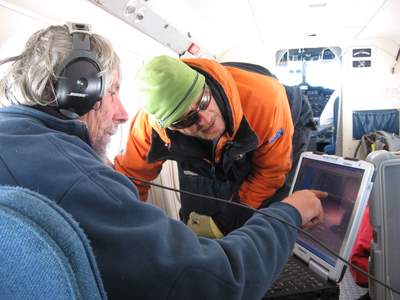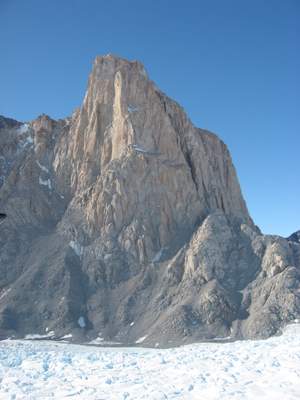Howard "Twit" Conway is a glacial geologist with our team. He is here studying how glaciers change over time. This season, he has been using radar as a tool to determine the thickness of various glaciers. From this, he is using the thickness of the ice to reconstruct past glacial change. While with our team, he and his brother, Maurice Conway, had two days of Twin OtterA highly maneuverable utility aircraft developed by de Havilland Canada. It can be flown slowly and in tight circles, and is designed for 20 passengers, short takeoffs and landings, and often used for cargo, passengers, and as a science platform. time which they spent flying low (about 400 feet above the glacier's surface) over the Beardmore and Shackleton Glaciers. They spent one day flying over each glacier. They found that the Beardmore glacier is currently about 1,000 m thick where is enters the Ross Ice Shelf; most likely, the glacier is thicker up near its head where it descends from the polar plateau. The Shackleton GlacierA mass of ice that persists for many years and notably deforms and flows under the influence of gravity. is a little thinner than the Beardmore.

Twit comes to glacial geology by an unconventional route. He obtained his Bachelor's of Engineering degree in Chemical Engineering from Canterbury University in Christchurch, New Zealand. He continued down the path of a Chemical Engineer when he received his Ph.D. from Canterbury University as well. His graduate work was on Mt. Cook, New Zealand where he studied avalanche mechanics as related to fluid flow. From there, Twit segued in glacial geology. His interest in avalanches came from being an avid back country skier and mountaineer. He was also fascinated by science so combining these was a logical choice.
Projects that Twit has been involved in in the past while in Antarctica are widely varied. He splits the majority of time between three themes: the history of glaciers, history of glacial streams, and core site selection. One project that he has also participated in was a study of the process of movement of cold based glaciers. (There are two types of glaciers: warm base and cold base. Warm base are warm enough at their bottom that the ice melts and the glacier moves along on a layer of water. Cold base are frozen at the bottom so the mechanism of movement differs from warm base glaciers.) This season, his research has focused on glacial history of the Transantarctic Mountains. Glacial streams are very rapidly moving (generally 300-500 m/year) portions of glaciers that tend to lie along the margins of glaciers; here they experience a lot of shear forces and are highly crevassed. He also uses radar to determine optimum locations for ice cores. This Antarctic season he has been defining core sites at Roosevelt Island in the eastern Ross Sea Ice Sheet and at the Western Antarctic Ice Sheet (WAIS) Divide. The WAIS Divide is the region dividing the eastern and western ice sheets. RadarA method of estimating the distance or travel speed of an object by bouncing high frequency signals off the object and measuring the reflected signal. can indicate areas of the ice where the layers are undisturbed. Ice cores are studied by other scientists who use the gas trapped in bubbles to determine past atmospheric conditions which can then be used to interpret how the climate has changed over time. These bubbles contain gases like methane, oxygen (isotopes of which are important indicators of many things like ocean and terrestrial productivity), and carbon dioxide. Ice cores also give valuable information about thinning of glaciers. If very thick layers form, scientists know that there was a period of increased precipitation resulting in accumulation of ice. If there are very thin layers, either the glacier was experiencing ablation (loss of ice through sublimation) or spreading out and thinning. The ice can also be dated using radiometric dating of the multiple volcanic ash layers embedded in the core. These dates are very important for constraining when climate change events and glacial thickening/thinning occurred.
He first came to Antarctica in 1979 in the capacity of mountaineer for a science expedition. The mountaineer for this research team fell ill, so he was asked if he'd like to join them. While on this trip, Twit's first impression was that it was "colder than snot". They were remotely camped in the Dry Valleys region in October. (October is a notoriously volatile season for weather - think about how March is where you live.) Despite this, he fell in love with the science and adventure that Antarctica holds. He's continued to return to Antarctica for 26 seasons now.
Twit is married and doesn't have any children. His wife, Leslie, is currently a science planner for Raytheon, the current Antarctic logistics provider for the United States Antarctic Program (USAP(abbreviation) United States Antarctic Program). Leslie has worked in one capacity or another for USAP(abbreviation) United States Antarctic Program logistics providers for many years. She was working at the Berg Field Center (BFC) helping to assist scientific research teams assemble their field gear when she met both Twit and Maurice. Leslie currently lives in Denver, Colorado while Twit is living in Seattle working at the University of Washington.

Twit will be back here next year, working on another project in the Transantarctic mountains. He plans on continuing to return for "as long as the science continues to fascinate" him. After this Antarctic season comes to a close, Twit will be heading off for a research expedition in Nepal. He will be located in Khumbu region near Mt. Everest.


Comments